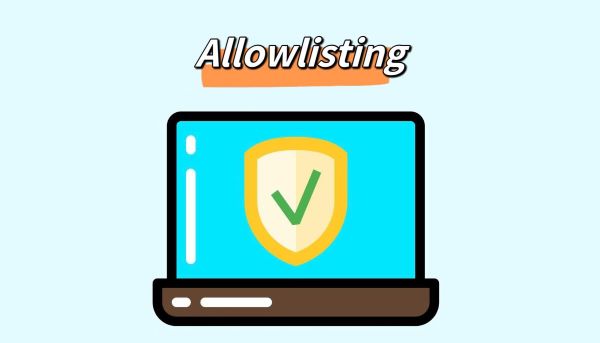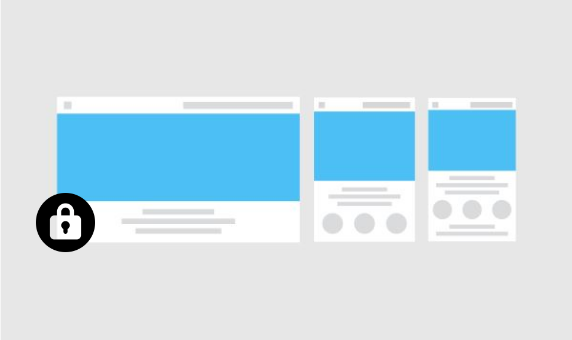Overview of Allowlisting - All You Need to Know [2024]
With the fast-growing technological trends in the last decade, security threats have also risen. So, individuals and enterprises need to adopt security features to ensure protection against the latest security threats. One effective remedy to ensure a healthy working environment in organizations is the allowlisting feature, which allows enterprises to run only trusted software on official devices. It is a valuable feature to comply with strict regulations to ensure data security.
In this article, we will discuss the allowlisting process in detail with ways to implement it on corporate devices and to evaluate the results.
- 1 : Understanding Why "Allowlisting" Matters
- 2 : What is the Process of Allowlisting?
- 3 : How to Evaluate the Implementation Result?
- 4 : Maintenance is the Most Challenging Aspect of Allowlisting
- 5 : Combine with MDM Solution to Achieve Device Control and Security

- 6 : The Difference Between Allowlisting And Blocklisting
- 7 : Best Practices of Application and Website Allowlisting
- 8 : How Does Allowlisting Work?
1. Understanding Why "Allowlisting" Matters
What is "Allowlisting"?
Allowlisting is a device management and trust-centric approach that helps enterprises create a list of applications, websites, and IP addresses to access official devices within system boundaries.
The effectiveness of allowlisting in corporate environments is enhanced by adding a maximum number of contents that are secure and necessary to perform business operations.

Why "Allowlisting" Matters?
- Allowlisting enables companies to have granular control over their system's endpoints and safeguard against malware infections and other security threats. Various business networks have incorporated the allowlist feature to allow only trusted websites, applications, and processes to run on official devices, keeping the corporate network safe.
- Effective deployment of allowlisting is necessary to ensure device and data security, which prevents financial and reputational loss. Malware and threat detection software must be regularly scanned because bugs and threats might be added when the software or a website is updated. So, it can be risky if the allowlist is not appropriately managed and updated regularly. Moreover, it also enhances employee productivity, reduce distractions, and costs by optimizing data usage.
- Safeguarding patients' information is the top priority in the healthcare industry. Similarly, government organizations' devices contain highly sensitive national data. App allowlisting enables them to add a list of specific authorized and necessary apps to conduct business operations. Users can only access the apps entered in the allowlist to prevent unauthorized entry into the system through malicious apps.
- Similarly, website allowlisting provides the safest browsing experience for enterprises, enhancing productivity and data security. Educational institutes use website allowlisting to add only educational URLs to the list. It helps admins restrict students' internet browsing to educational purposes only, preventing them from inappropriate content and personality damage.
2. What is the Process of Allowlisting?
Different businesses have different work requirements and needs. So, they can choose apps and other entities they need to run the business. Here are some critical steps to ensure effective allowlisting for businesses.
- Identification and evaluation parameters
Identifying a business's needs and requirements is crucial initially. So, identify which entities are required to allow access on official devices. When choosing the entities, consider compliance, business policies, risk assessments, and resources. Allowlisting can be done for software, websites, IP addresses, and users. - List creation
Considering the evaluation criteria, list the necessary tools and entities required to run business operations effectively and add them to the allowlist for configuration. Make sure to configure security checks like firewalls to prevent data breaches and disruptions. - Testing
It is essential to cross-check whether the allowlist settings are appropriately working. Try different websites and apps to access the devices and then match them with the allowlist to ensure they work effectively. - Deployment
After preparing the list and testing, deploy the allowlisting configuration on specified systems, networks, platforms, and devices. Make sure it is adequately enforced to avoid future issues. - Regularly review the allowlist.
It is crucial to regularly review the allowlist to ensure that all websites and other entities are safe to use after updates. The list might also change due to the availability of new tools.
3. How to Evaluate the Implementation Result?
Consider the following parameters to evaluate the implementation result for allowinglist:
- Verify the access logs implemented on devices by trying to access a specific app or website. Analyze the logs by comparing them with the allowlist to check that only authorized entities are accessible while others are blocked. If this is happening, then it means the allowlist is effectively operational.
- Test allowlist restrictions in multiple ways. Use different entities, such as applications, websites, devices, and IP addresses, to ensure every single entity has a controlled working environment.
- Try evaluating the response of the allowlist towards security incidents. Check if it effectively prevents unauthorized access.
- Feedback is a productive way to evaluate any policy. Ask users and other admins who use devices protected by an allowlist about the challenges they face. Then, make informed decisions to overcome them.
- Make sure the allowlist implementation policy complies with regulatory requirements and organizational policies. Also, ensure no important entity is left to add to the allowlist that hinders work productivity.
4. Maintenance is the Most Challenging Aspect of Allowlisting
Although maintenance is the most challenging part of implementing allowlisting, achieving effectiveness is crucial.
The process involves maintaining the allowlist (also named as a content list), which helps to allow only the trusted entities and blocks all the others. It is especially challenging for businesses with IT infrastructure because it is dynamic and needs regular monitoring to ensure smooth working.
In the IT industry, new applications, websites, and online resources are constantly being introduced and updated with time, reminding us of the need to update the allowlist constantly.
Enterprises with large-scale devices are challenging to manage. But thanks to technology enabling them to use device management solutions that provide ease of deployment, management, monitoring, and remote control, a powerful and convenient mobile device management tool helps to improve shared controls and distribute apps and security policies equally on all managed devices from a central location, leading to compliance and enhanced security.
5. Combine with MDM Solution to Achieve Device Control and Security
AirDroid Business MDM solution offers allowlisting capabilities and centralizes device management within a single control panel, enabling the IT team to efficiently configure and apply allowlists to device groups.
- App Allowlist of Kiosk Mode
Admins can remotely upload custom apps in app library or download them directly from Google Play Store to distribute them on managed devices using AirDroid’s Dashboard. Then using app allowlist feature of AirDroid Business, they can select the apps to access on all connected devices. - Kiosk Browser
Kiosk browser is a valuable feature for providing the safest browsing experience on corporate devices. Adding kiosk browser in app allowlisting ensures only kiosk browser can run on managed devices, customize the auto-run page to avoid distractions and prevent users to exit the browser without admin’s permission. - Phone Number Allowlisting
Establish the contact whitelist that permits corporate-managed devices to only place and accept calls from approved numbers.
6. The Difference Between Allowlisting And Blocklisting
The primary goal of allowlisting and blocklisting is almost the same, as both are utilized to enforce restricted work environments to protect official devices from cyber-attacks. Their differences are:
| Working Principles | Safety Level | Summary | |
|---|---|---|---|
| Allowlisting | Allowlisting helps enterprises enforce official devices to access only the selected apps, websites, IP addresses, and emails, preventing all other apps and functions from accessing. | ⭐⭐⭐⭐⭐ | Allowlisting is a more comprehensive and restrictive approach as it prevents access to every website or app other than those added to the list. |
| Blocklisting | Blocklisting helps enterprises block all known vulnerabilities, such as applications, websites, or IP addresses that are suspicious and unsafe. | ⭐⭐⭐⭐ | Blocklisting is difficult to manage and needs regular additions as new vulnerabilities are detected, but admins cannot block access to all malicious entities using blocklisting. |
7. Best Practices of Application and Website Allowlisting
Application allowlisting
Well-reputed healthcare centers utilize app allowlisting features to run only verified and healthcare-related apps for management and patient care. Medical staff needs multiple apps to check patients and make informed decisions. Some essential apps medical staff use include electronic health record (EHR) software, medical imaging applications, testing apps, and similar apps concerned with patient treatment and clinical management.
Hospital management adds only these apps to the allowlist to ensure the safety of sensitive data and keep the medical staff productive without distractions.
A manufacturing company installs application allowlisting on its industrial control systems (ICS) as a medium to achieve a balance between operational continuity and security. To access the critical infrastructure, only authorized applications, including supervisory control and data acquisition (SCADA) software, manufacturing execution systems (MES), and maintenance tools, are allowed to execute on official devices, denying other unnecessary applications. It minimizes the possibility of cyber-attacks intended on industrial systems.

Website allowlisting
Colleges implement a policy of website allowlisting on students' devices to make internet use secure and limited. Students can only access educational websites and LMS (Learning Management System), where teacher-created materials and reports are the only ones allowed. Social media, gaming, and other non-educational sources are prohibited. In this case, privacy is ensured, while the study process is not deterred by inappropriate content.
Similarly, government agencies establish website allowlisting for their employees' internet browsing experience. Only websites endorsed by the government, such as official sites, research databases, and specific national data, can be accessed from agency-issued devices. It, in turn, will keep the workers away from potentially harmful or non-compliant websites, promoting productivity and compliance.
8. How Does Allowlisting Work?
A simple process of allow listing includes creating a pre-defined list of accessible and necessary tools and applying settings on devices to ensure that only selected applications or other entities can run on them.
The user types in the search bar to access any app, website, IP address, or content as trusted entities. A request is sent to the server, and the system matches it with the allowlist to see whether that searched entity is available there. The request is denied if it is not found in the list, while access is granted if the searched tool or website is available in the list.
9. Final Words
Allowlisting is a cyber-security feature used on personal and corporate devices to ensure limited and secure usage. In the corporate sector, admins use an MDM solution to manage security and control overall device activities and usage. Due to dynamic IT infrastructure, allowlisting requires continuous monitoring and updates. MDM solutions like AirDroid Business help admins implement kiosk mode on all managed devices and allow single or multiple apps to run on devices. MDM also provides additional features like remote control, wipe, multi-factor authentication, Wi-Fi, and other network policies to ensure high-end security and meet compliance.






Leave a Reply.